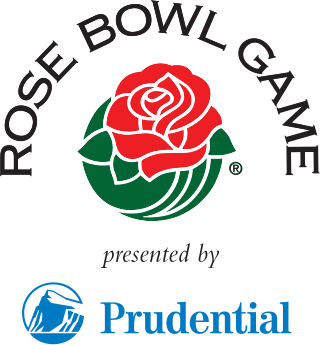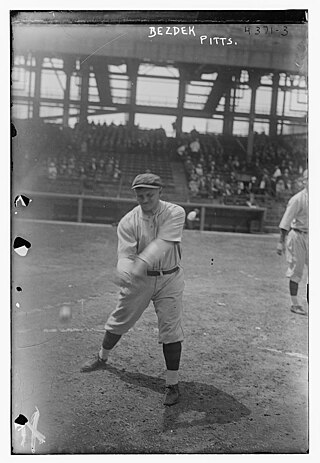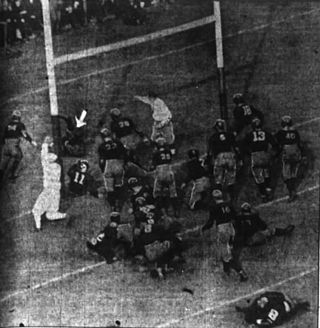
The Rose Bowl Game is an annual American college football bowl game, traditionally played on January 1 at the Rose Bowl in Pasadena, California. When New Year's Day falls on a Sunday, the game is played on Monday, January 2. Nicknamed "The Granddaddy of Them All" by broadcaster Keith Jackson, it was the first postseason football game ever established. The Rose Bowl Game was first played in 1902 as the Tournament East–West football game, and has been played annually since 1916. Since 1945, it has been the highest attended college football bowl game. The game is a part of the Pasadena Tournament of Roses Association's "America's New Year Celebration", which also includes the historic Rose Parade. Winners of the game receive the Leishman Trophy, named for former Tournament of Roses presidents, William L. Leishman and Lathrop K. Leishman who played an important part in the history of this game.

The Rose Bowl is an outdoor athletic stadium located in Pasadena, California. Opened in October 1922, the stadium is recognized as a National Historic Landmark and a California Historic Civil Engineering landmark. At a modern capacity of an all-seated configuration at 92,542, the Rose Bowl is the 16th-largest stadium in the world, the 11th-largest stadium in the United States, and the 10th-largest NCAA stadium. The stadium is 10 miles (16 km) northeast of downtown Los Angeles.

Hugo Francis Bezdek was a Czech American athlete who played American football and was a coach of football, basketball, and baseball. He was the head football coach at the University of Oregon, the University of Arkansas (1908–1912), Pennsylvania State University (1918–1929), and Delaware Valley College (1949). Bezdek also coached the Mare Island Marines in the 1918 Rose Bowl and the Cleveland Rams of the National Football League (NFL) in 1937 and part of the 1938 season. In addition, Bezdek coached basketball at Oregon and Penn State (1919), coached baseball at Arkansas (1909–1913), Oregon (1914–1917) and Penn State (1920–1930), and served as the manager of Major League Baseball's Pittsburgh Pirates (1917–1919). He was inducted into the College Football Hall of Fame as a coach in 1954.

Elmer Clinton "Gloomy Gus" Henderson was an American football coach. He served as the head coach at the University of Southern California (1919–1924), the University of Tulsa (1925–1935), and Occidental College (1940–1942), compiling a career college football record of 126–42–7. Henderson's career winning percentage of .865 at USC is the best of any Trojans football coach, and his 70 wins with the Tulsa Golden Hurricane remain a team record. In between his stints at Tulsa and Occidental, Henderson moved to the professional ranks, helming the Los Angeles Bulldogs of the American Football League in 1937 and the Detroit Lions of the National Football League (NFL) in 1939. Henderson also coached basketball and baseball at USC, each for two seasons.
The 2003 Rose Bowl was a college football bowl game played on January 1, 2003. It was the 89th Rose Bowl game. It was a match-up between the Oklahoma Sooners and the Washington State Cougars. Oklahoma led 27–0 in the fourth quarter and won, 34–14. Sooner quarterback Nate Hybl was named the Player Of The Game.
The 1995 Rose Bowl was a college football bowl game played on Monday January 2, 1995, because New Year's Day was on a Sunday. It was the 81st Rose Bowl Game. The Penn State Nittany Lions defeated the Oregon Ducks 38–20. Ki-Jana Carter of Penn State and Danny O'Neil of Oregon both were named the Rose Bowl Players of the Game. Many observers point to this game as the one that made Ki-Jana Carter a number one selection in the 1995 NFL Draft.
The 1989 Rose Bowl was the 75th edition of the college football bowl game, played at the Rose Bowl in Pasadena, California, on Monday, January 2. This year marked the 100th anniversary of the Tournament of Roses parade. The Michigan Wolverines of the Big Ten Conference upset the fifth-ranked USC Trojans of the Pacific-10 Conference, 22–14. Down by eleven points at halftime, the Wolverines shut out the Trojans in the second half and won by eight. Michigan fullback Leroy Hoard was named the Player of the Game.
The 1943 Rose Bowl game was the 29th edition of the college football bowl game, played at the Rose Bowl in Pasadena, California, on Friday, January 1. The second-ranked Georgia Bulldogs of the Southeastern Conference (SEC) defeated the #13 UCLA Bruins of the Pacific Coast Conference (PCC), 9–0.
The 1973 Rose Bowl was the 59th edition of the college football bowl game, played at the Rose Bowl in Pasadena, California, on Monday, January 1. It matched the undefeated and top-ranked USC Trojans of the Pacific-8 Conference with the #3 Ohio State Buckeyes of the Big Ten Conference.

The 1922 college football season had a number of unbeaten and untied teams, and no clear-cut champion, with the Official NCAA Division I Football Records Book listing California, Cornell, Iowa, Princeton, and Vanderbilt as national champions. California, Cornell, and Princeton were all picked by multiple selectors.
The 1940 Rose Bowl was the 26th edition of the college football bowl game, played at the Rose Bowl in Pasadena, California, on Monday, January 1.
The 1934 Rose Bowl, played on January 1, 1934, was an American football bowl game. It was the 20th Rose Bowl Game. The Columbia Lions defeated the Stanford Indians 7-0. Cliff Montgomery, the Columbia quarterback, was named the Rose Bowl Player Of The Game when the award was created in 1953 and selections were made retroactively. At 35,000, it has the lowest attendance in the Rose Bowl game since the Rose Bowl Stadium was built in 1922. This was one of the few rainy New Year's Day celebrations in Pasadena, California. Rain three days before had turned the Rose Bowl stadium into a small lake.
The 2009 Rose Bowl, the 95th edition of the annual game, was a college football bowl game played on Thursday, January 1, 2009 at the same-named stadium in Pasadena, California. Because of sponsorship by Citi, the first game in the 2009 edition of the Bowl Championship Series was officially titled the Rose Bowl Game presented by Citi. The contest was televised on ABC with a radio broadcast on ESPN Radio beginning at 4:30 PM US EST with kickoff at 5:10 PM. Ticket prices for all seats in the Rose Bowl were listed at $145. The Rose Bowl Game was a contractual sell-out, with 64,500 tickets allocated to the participating teams and conferences. The remaining tickets went to the Tournament of Roses members, sponsors, City of Pasadena residents, and the general public.
The 1932 Rose Bowl was the 18th Rose Bowl game, an American post-season college football game that was played on New Year's Day 1932 in Pasadena, California. It featured the Tulane Green Wave against the USC Trojans. The Trojans had six All-Americans in their lineup: tackle Ernie Smith, guards Johnny Baker and Aaron "Rosy" Rosenberg, halfback Erny Pinckert and quarterbacks Orville Mohler and Gaius Shaver.
The 1933 Stanford Indians football team represented Stanford University as a member of the Pacific Coast Conference (PCC) during the 1933 college football season. Led by first-year head coach Claude E. Thornhill, the Indians compiled an overall record of 8–2–1 with a mark of 4–1 in conference play, sharing the PCC title with Oregon. Stanford was invited to the Rose Bowl, where Indians lost to Columbia. The team played home games at Stanford Stadium in Stanford, California.
The 1982 Fiesta Bowl was the eleventh edition of the college football bowl game, played at Sun Devil Stadium in Tempe, Arizona on Friday, January 1. Part of the 1981–82 bowl game season, it matched the seventh-ranked independent Penn State Nittany Lions and the #8 USC Trojans of the Pacific-10 Conference. A slight underdog, Penn State won, 26–10.
The 2017 Rose Bowl was a college football bowl game played on January 2, 2017 at the Rose Bowl stadium in Pasadena, California. This 103rd Rose Bowl Game matched the Big Ten Conference champions Penn State Nittany Lions against the USC Trojans of the Pac-12 Conference, a rematch of the 1923 and 2009 Rose Bowls, the former the first appearance for either team in the bowl and the latter the most recent appearance for either team. It was one of the 2016–17 bowl games that concluded the 2016 FBS football season. Sponsored by the Northwestern Mutual financial services organization, the game was officially known as the Rose Bowl Game presented by Northwestern Mutual. USC received the Lathrop K. Leishman trophy for winning the game.
The 2023 Rose Bowl was a college football bowl game played on January 2, 2023, at the Rose Bowl in Pasadena, California. The 109th annual Rose Bowl, the game featured Penn State from the Big Ten Conference and Utah from the Pac-12 Conference. The game began at 2:11 p.m. PST and was aired on ESPN and ESPN Radio. It was one of the 2022–23 bowl games concluding the 2022 FBS football season. Sponsored by Prudential Financial, the game is officially known as The Rose Bowl Game presented by Prudential.

The 2024 USC Trojans football team will represent the University of Southern California (USC) as a first-year member of the Big Ten Conference during the 2024 NCAA Division I FBS football season. The team is led by their third-year head coach Lincoln Riley, and will play their home games at Los Angeles Memorial Coliseum located in Los Angeles.

The 2024 UCLA Bruins football team will represent the University of California, Los Angeles in the Big Ten Conference during the 2024 NCAA Division I FBS football season. The Bruins play their home games at the Rose Bowl located in Pasadena, California.







